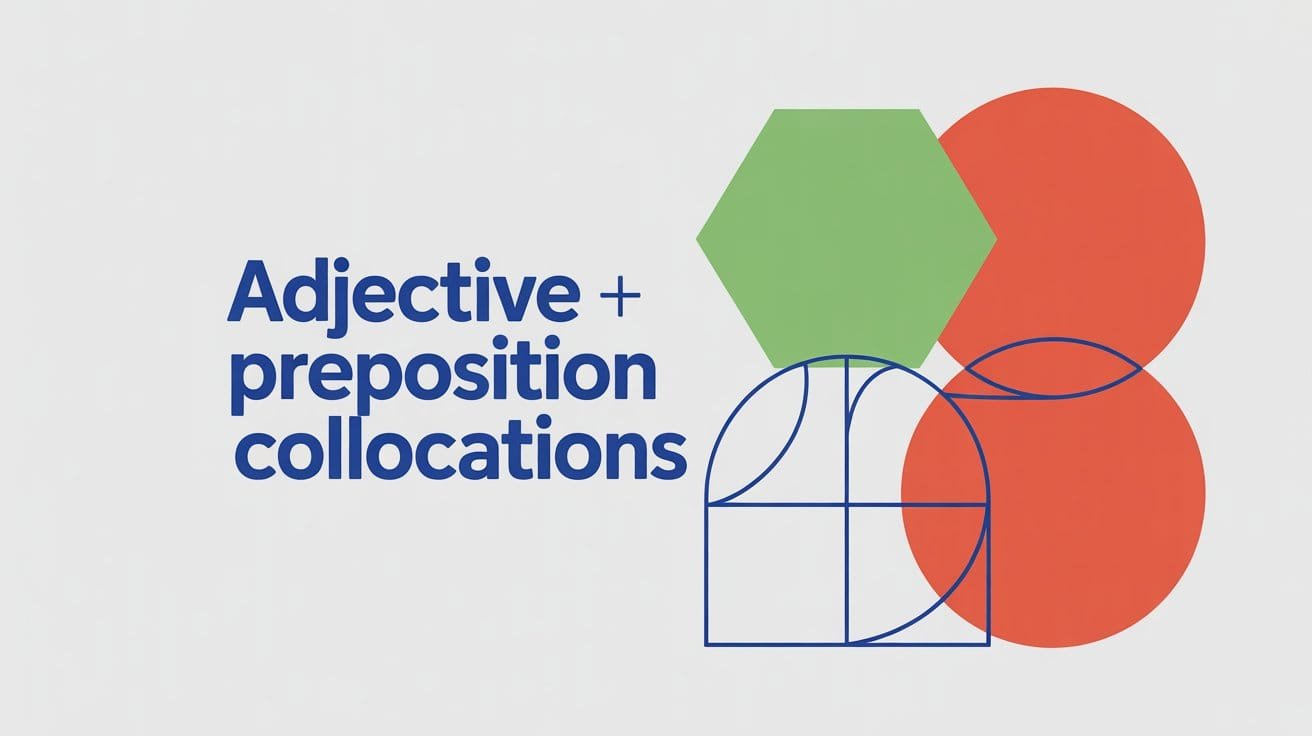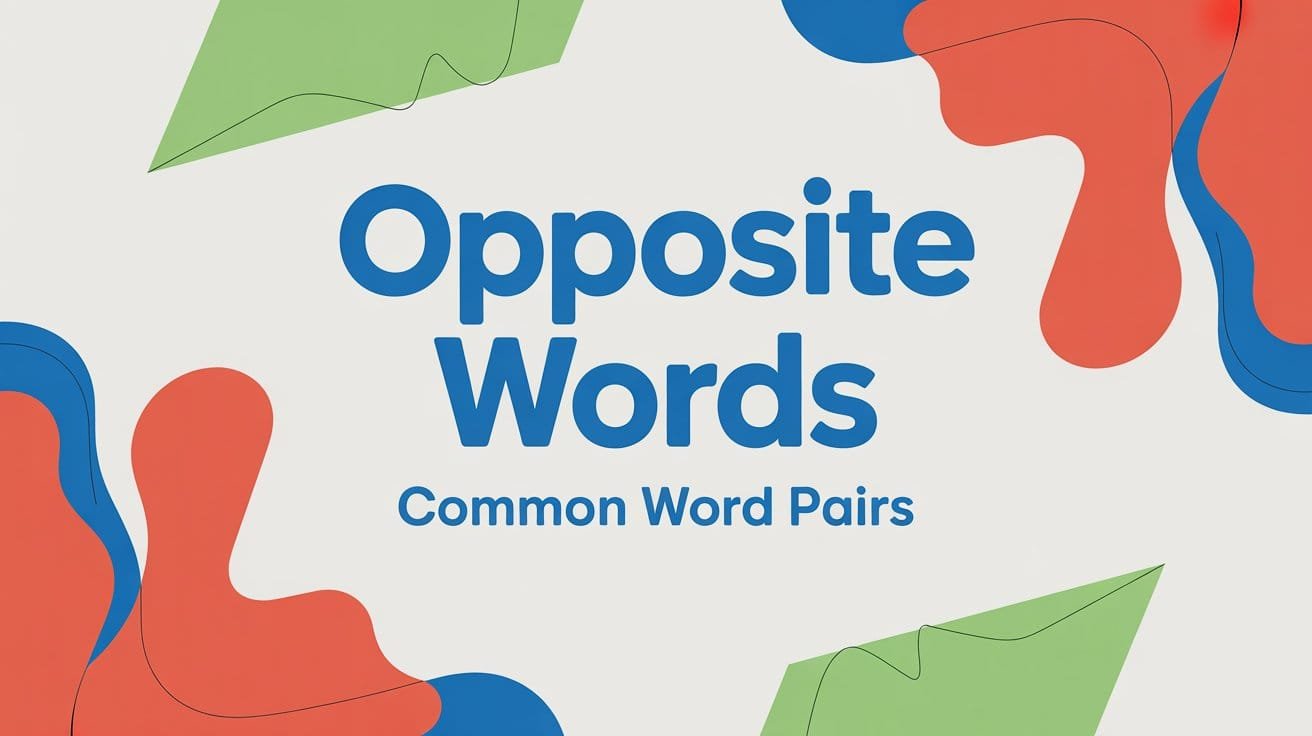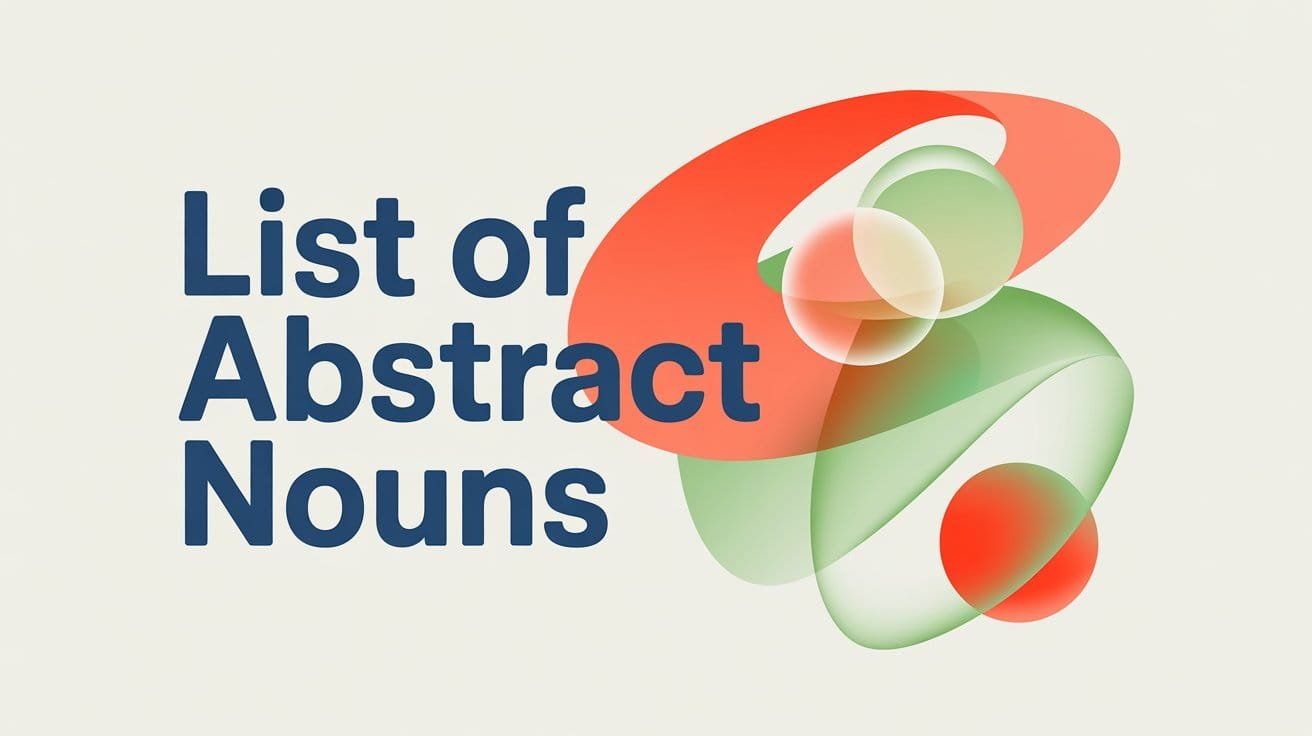Some adjectives in English naturally pair with specific prepositions — and using the wrong one can make your sentence sound awkward or confusing. We say interested in, not interested on, and afraid of, not afraid from. These natural pairings are known as adjective + preposition collocations.
In this guide, you’ll learn the most common adjective preposition collocations in English, understand how their meanings change with different prepositions, and see how to use them correctly in your own sentences.
Understanding Adjective + Preposition Collocations
An adjective + preposition collocation is a natural combination where a specific adjective is almost always followed by a particular preposition. These pairs express emotions, opinions, attitudes, or relationships between ideas — and choosing the wrong preposition can completely change the meaning or make a sentence sound unnatural.
For example:
- afraid of heights ✅ (correct and natural)
- afraid from heights ❌ (unnatural)
- good at playing chess ✅
- good in playing chess ❌
Both versions may look grammatically possible, but only one is used by native speakers. The difference lies in frequency and convention — native speakers have used these combinations so often that they’ve become fixed in everyday English.
Not all adjectives pair with only one preposition. Some take different prepositions depending on the meaning:
- angry at a person’s behavior → He was angry at her rude comment.
- angry with someone → She was angry with her brother.
- angry about a situation → We’re angry about the delay.
Common Adjective + Preposition Collocations (with Examples)
Adjective + preposition collocations appear constantly in everyday English — in conversations, emails, and even academic writing. Below are some of the most common and useful pairings, grouped by their prepositions.
Adjectives + of
These combinations often describe emotions, opinions, or qualities.
- afraid of — She’s afraid of spiders.
- proud of — He’s proud of his achievements.
- aware of — Are you aware of the new rules?
- capable of — She’s capable of solving complex problems.
- full of — The basket is full of apples.
- tired of — I’m tired of waiting.
- jealous of — He’s jealous of his colleague’s success.
- fond of — She’s fond of classical music.
- ashamed of — He felt ashamed of his behavior.
- certain of — I’m certain of the answer.
Adjectives + at
Used to show ability, skill, or reactions to something.
- good at — She’s good at drawing.
- bad at — I’m bad at remembering names.
- brilliant at — He’s brilliant at solving puzzles.
- terrible at — We’re terrible at directions.
- surprised at — They were surprised at the news.
- amazed at — I was amazed at her performance.
- angry at — She was angry at the delay.
- delighted at — We were delighted at the invitation.
- disappointed at — He felt disappointed at the outcome.
- hopeless at — I’m hopeless at cooking.
Adjectives + about
These combinations often express feelings or opinions regarding a topic.
- worried about — She’s worried about her exams.
- excited about — I’m excited about my new job.
- nervous about — They were nervous about the interview.
- concerned about — We’re concerned about climate change.
- happy about — He’s happy about the results.
- sad about — She’s sad about the breakup.
- anxious about — I’m anxious about tomorrow’s test.
- curious about — He’s curious about how things work.
- angry about — People are angry about the delay.
- enthusiastic about — She’s enthusiastic about volunteering.
Adjectives + for
Used to show purpose, reason, or emotion toward something.
- famous for — Paris is famous for its art and culture.
- responsible for — He’s responsible for managing the team.
- known for — This café is known for its desserts.
- ready for — Are you ready for the exam?
- suitable for — This movie isn’t suitable for children.
- grateful for — I’m grateful for your help.
- thankful for — We’re thankful for the support.
- qualified for — She’s qualified for the position.
- eager for — He’s eager for a challenge.
- late for — I was late for the meeting.
Adjectives + to
These collocations often show reactions, relationships, or connections.
- kind to — She’s always kind to strangers.
- rude to — He was rude to the waiter.
- nice to — It was nice to meet you.
- married to — She’s married to a musician.
- similar to — Your dress is similar to mine.
- allergic to — He’s allergic to peanuts.
- opposed to — They’re opposed to the plan.
- used to — I’m used to waking up early.
- attached to — She’s attached to her hometown.
- sensitive to — He’s sensitive to criticism.
Adjectives + with
Used to describe relationships, satisfaction, or feelings toward something.
- pleased with — I’m pleased with the results.
- bored with — They’re bored with routine tasks.
- satisfied with — She’s satisfied with her progress.
- fed up with — I’m fed up with waiting in line.
- angry with — He was angry with his brother.
- friendly with — She’s friendly with her neighbors.
- patient with — You need to be patient with children.
- delighted with — They were delighted with the outcome.
- careful with — Be careful with that glass.
- happy with — I’m happy with the service.
Formal and Academic Adjective + Preposition Collocations
In academic and professional writing, adjective + preposition collocations make sentences sound polished and precise. Here are some common patterns you’ll see in essays, reports, and business writing.
Adjectives Showing Relationship or Relevance
- relevant to — The data is relevant to the current study.
- related to — This issue is related to energy efficiency.
- appropriate for — This method is appropriate for advanced learners.
- applicable to — The rule is applicable to all departments.
- consistent with — The results are consistent with previous research.
Adjectives Showing Dependence or Necessity
- dependent on — The outcome is dependent on external factors.
- essential to — Critical thinking is essential to problem-solving.
- necessary for — Funding is necessary for completing the project.
- crucial to — Clear instructions are crucial to successful teamwork.
- responsible for — The manager is responsible for final approval.
Adjectives Showing Attitude or Evaluation
- concerned with — This paper is concerned with linguistic variation.
- committed to — The team is committed to improving standards.
- interested in — Students are interested in cross-cultural studies.
- involved in — He’s involved in renewable energy research.
- dedicated to — The foundation is dedicated to social development.
Adjectives Expressing Readiness or Capability
- capable of — The system is capable of processing large data sets.
- suitable for — This approach is suitable for beginners.
- ready for — The report is ready for publication.
- prepared for — They were prepared for unexpected changes.
- qualified for — She’s qualified for the managerial position.
Patterns and Preposition Classes in Adjective + Preposition Collocations
Many adjectives in English are commonly paired with specific prepositions. These adjective-preposition combinations often follow consistent patterns, and understanding these patterns can make it easier to remember which preposition to use with each adjective.
1. Adjectives + of
Used to express feelings, characteristics, or possession.
- afraid of — He’s afraid of snakes.
- capable of — She’s capable of great kindness.
- jealous of — He’s jealous of his friend’s success.
- full of — The jar is full of cookies.
- ashamed of — She was ashamed of lying.
2. Adjectives + at
Commonly used to show ability, reaction, or evaluation. The preposition at usually follows adjectives related to skill, emotion, or surprise.
- good at — He’s good at painting.
- bad at — I’m bad at remembering birthdays.
- brilliant at — She’s brilliant at designing layouts.
- angry at — They were angry at the delay.
- amazed at — I was amazed at her confidence.
3. Adjectives + for
Used to express reason, purpose, or qualification.
- responsible for — He’s responsible for the team’s success.
- famous for — The city is famous for its festivals.
- suitable for — This course is suitable for beginners.
- grateful for — I’m grateful for your advice.
- qualified for — She’s qualified for the promotion.
4. Adjectives + to
Show connection, relation, or behavior toward something.
- kind to — She’s kind to animals.
- rude to — He was rude to the waiter.
- married to — She’s married to a pilot.
- similar to — Your idea is similar to mine.
- allergic to — He’s allergic to peanuts.
5. Adjectives + about
Used to show emotion, concern, or thought about a topic.
- worried about — I’m worried about the deadline.
- excited about — She’s excited about her trip.
- nervous about — He’s nervous about the interview.
- angry about — They’re angry about the decision.
- curious about — I’m curious about your project.
6. Adjectives + with
Describe reactions, satisfaction, or feelings toward people or things. The preposition with often follows adjectives that describe personal reactions or emotions.
- pleased with — I’m pleased with my progress.
- angry with — She’s angry with her brother.
- bored with — They’re bored with routine work.
- satisfied with — He’s satisfied with the result.
- fed up with — I’m fed up with traffic jams.
7. Adjectives That Take Multiple Prepositions
Some adjectives change meaning depending on the preposition used.
- different from / different to / different than — British English prefers different to, while American English uses different from or different than.
- angry at / angry with / angry about — He’s angry at the situation but angry with the person who caused it.
- good at / good for — She’s good at teaching but that’s also good for her career.
Mixed or Extended Adjective + Preposition Collocations
Adjective + preposition collocations often appear in longer phrases. These extended forms usually include gerunds (verbs ending in -ing), noun phrases, or clauses — giving sentences a smoother and more expressive tone.
Adjective + Preposition + Gerund
When an adjective collocation is followed by a verb ending in -ing, the preposition connects the two naturally.
- afraid of flying — She’s afraid of flying, so she takes the train.
- interested in learning — He’s interested in learning new languages.
- tired of waiting — I’m tired of waiting for your reply.
- capable of achieving — They’re capable of achieving great success.
- responsible for managing — He’s responsible for managing the project team.
Adjective + Preposition + Noun Phrase
In this pattern, the collocation is followed by a noun or noun phrase to complete the meaning. These phrases help express attitude and emotion clearly.
- worried about the exam — She’s worried about the exam next week.
- excited about the opportunity — He’s excited about the opportunity to travel abroad.
- proud of his team — The coach was proud of his team after the win.
- angry with the manager — They’re angry with the manager for cancelling the trip.
- grateful for your help — I’m grateful for your help with this project.
Adjective + Preposition + Clause
Some collocations are extended by adding a clause introduced by that, when, or if.
- sure of that — I’m sure of that decision.
- certain that — We’re certain that the plan will work.
- concerned that — They’re concerned that prices may rise.
- happy that — I’m happy that you got the job.
- afraid that — She’s afraid that she might miss the train.
Multi-Word Collocations in Context
Sometimes adjective + preposition collocations appear in longer, descriptive phrases that sound completely natural.
- committed to improving performance
- interested in exploring new methods
- famous for producing high-quality products
- capable of handling large datasets
- concerned about the growing problem
Tips to Learn and Use Adjective + Preposition Collocations Effectively
Learning adjective + preposition collocations takes practice and exposure. Since these combinations depend on usage rather than strict grammar rules, it’s best to focus on patterns, not memorization.
Learn Adjectives with Their Prepositions Together
Always study the adjective and its preposition as one unit — like interested in or good at — instead of learning them separately.
Notice Collocations in Context
When reading or listening to English, pay attention to adjective + preposition combinations. Highlight or write them down with short examples.
Example:
- concerned about the results
- responsible for customer service
- excited about the opportunity
Group Collocations by Preposition
Organizing collocations by their prepositions makes patterns easier to spot and recall.
Example:
- of: afraid of, proud of, aware of
- at: good at, brilliant at, surprised at
- for: responsible for, suitable for, grateful for
Practice Through Writing and Speaking
Use adjective + preposition collocations in your sentences, emails, or short paragraphs.
Examples:
- I’m proud of my team’s effort.
- He’s capable of solving complex problems.
- They’re excited about launching the new product.
Use Collocation Tools and Dictionaries
Websites like the Oxford Collocations Dictionary, JustTheWord, or the British National Corpus show which prepositions commonly appear with specific adjectives.
Review and Recycle Regularly
Repetition is key to long-term memory. Review your list of adjective + preposition pairs weekly, and try using them in different contexts. For example:
- good at drawing → good at organizing
- afraid of dogs → afraid of failure
Frequently Asked Questions about Adjective + Preposition Collocations
What is an adjective + preposition collocation?
An adjective + preposition collocation is a natural combination where a specific adjective regularly pairs with a certain preposition. For example, afraid of, interested in, and good at are fixed expressions that native speakers use naturally.
Why can’t I use any preposition after an adjective?
Not all prepositions fit every adjective. English relies on usage, not direct logic. For example, we say interested in music ✅ but not interested on music ❌. Native speakers have used these pairings so frequently that they’ve become standard.
What are some common adjective + preposition collocations?
Here are some examples you’ll hear often:
proud of
good at
afraid of
responsible for
interested in
similar to
angry with
excited about
pleased with
famous for
Are there adjectives that can take more than one preposition?
Yes, some adjectives change meaning depending on the preposition used.
Examples:
angry with (a person), angry about (a situation), angry at (an action)
different from, different to, or different than (depending on region)
good at (ability), good for (benefit)
These variations depend on meaning and context.
Can adjective + preposition collocations be followed by verbs?
Yes, when followed by a verb, the verb usually takes the -ing form (a gerund).
Examples:
afraid of flying
interested in learning
capable of solving problems
responsible for managing a project



